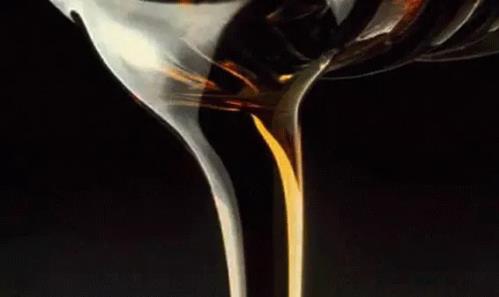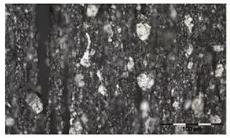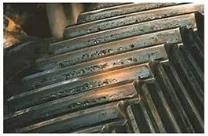Contamination of lubricating oil is a complicated problem. Sometimes it can be found by daily inspection, but not in some cases, and some contamination cannot be observed by naked eyes. Moreover, for all pollution, when it can be detected by the naked eye, it indicates that it is already serious. In short, the contamination of lubricating oil should be detected and treated early, especially for more sensitive and critical equipment. Oil detection can accurately analyze the contaminants in lubricating oil by detecting oil, just like finding abnormal conditions in the human body through blood testing.

1. Particulate matter
Particulate matter is one of the most harmful pollutants. They enter the lubrication system and cause abrasive wear, metal crushing and scratching, and metal fatigue. Particles generally have a certain degree of hardness. Many particles are very small in size and can pass through the gaps between parts and circulate inside the equipment, causing wear. Common particles include dust, grit, fine metal particles, rust and slag generated during equipment operation.

Metal fatigue

Pits formed by abrasion of the metal surface
Particulate pollution not only harms the equipment itself, but also shortens the life of the lubricant. Abrasive wear will increase the metal powder content in the oil. These fine metal particles will not only further wear the equipment, but also accelerate the oxidation and deterioration of the lubricant, because the metal powder will catalyze the oxidation rate of the oil. Given that the hazards of these particles are chained, it is important to monitor and deal with them early.
Oil testing can find fine particles in the oil, as well as early wear and tear of equipment. By detecting the particle count in the oil, we can understand the cleanliness of the oil and whether it has entered particulate contaminants. In addition, through the analysis of metal elements, we can find the early wear of the equipment. When the particulate matter and the metal of the equipment are abrasively worn, the scraped metal can be monitored. Through the analysis of the element and composition of the metal, the wear source can also be found. For example, the material of the gear is mostly iron with a small amount of other alloy components (chromium, nickel, manganese, etc.).
If particulate matter is found to enter the lubricating oil, general remedial measures include: finding where the particulate matter came in, then blocking the source, filtering to remove the particulate matter-but this approach is not always effective. Sometimes it is difficult to filter the oil to completely remove the particles, and the oil has to be replaced. If the wear is obvious, it is recommended to perform a ferrography analysis to determine the degree of wear and guide equipment maintenance.
For the removal of particulate matter from lubricating oils, PureTech offers you different types of machines. Such as Vacuum Oil Purifier (removal of particulate matters, moisture, gas), Portable Oil Filter Cart (removal of particulate matters with filter cartridges), Portable Plate and Frame Filter Cart (removal of particulate matters with filter paper), Centrifuge Separators (removal of particulate matters and water), etc.
2. Moisture
Moisture is a common pollutant. Although the harm is not as serious as particulate matter, it can destroy the lubrication effect, deteriorate the oil, and cause equipment wear. Moisture can also cause metal corrosion. There are three forms of water in lubricating oil: dissolved water, emulsified water, and free water. Among them, emulsified water is the most harmful.
Dissolved water is the water that has been dissolved in the lubricating oil. Lubricating oil is hygroscopic and will absorb moisture in the air, so it will contain a small amount of moisture. Generally speaking, a small amount of dissolved water will not cause any harm, unless certain circumstances require particularly strict requirements for the water content of the lubricant. The maximum allowable dissolved water content of lubricating oil is the water absorption saturation point. Before reaching the water absorption saturation point, although the lubricating oil contains water, it will not show signs of water, such as emulsification, turbidity, and reduced transparency.
After the lubricating oil enters the water, if it is not separated from the oil, the tiny water droplets are suspended in the oil and become a suspension, which becomes emulsified water. Emulsified water is the most harmful. When the lubricating oil is emulsified, the water content has exceeded the saturation point. When the oil contains emulsified water, the transparency of the lubricating oil will be reduced, turbid, white in color or even milky white. Emulsified water is very harmful because it can flow freely and contaminate the oil in the entire lubrication system. In addition, water will destroy the lubricity of the oil. After the emulsified water reaches the pressure-bearing area where the equipment is running, these areas will be poorly lubricated, increased friction and wear.
When water and lubricating oil are completely separated, it becomes free water. Free water is relatively less harmful, but it can also cause problems. First, free water may also circulate with the lubricating oil, causing oil to emulsify. In addition, the water in the oil will weaken the demulsibility of the lubricating oil, resulting in increased foam, consumption of additives in the lubricating oil, shortening the life of the lubricating oil, and easy to breed bacteria.
In addition to poor lubrication, the damage to equipment caused by moisture includes hydrogen embrittlement and rust. Lubricating oil can prevent metal corrosion. If water enters the oil, it will easily cause metal corrosion.
Humid atmosphere and free moisture may cause hydrogen embrittlement of metals. Hydrogen embrittlement is also called hydrogen damage, which can cause bearing damage. Water will decompose into hydrogen and oxygen. Electrolysis and corrosion will also produce hydrogen. Water will promote electrolysis and corrosion. High-strength steel is particularly vulnerable to this problem. In addition, the additives added to lubricating oil and grease contain sulfur (extreme pressure additives, anti-wear agents, etc.). Mineral oil itself also contains certain sulfur impurities, which will promote metal corrosion and cracking.
Moisture will destroy the strength of the oil film and the integrity of the oil film. Lubrication relies on the oil to form an oil film between the metal contact surfaces. The oil film separates the direct friction between metals and prevents direct metal contact. If moisture enters the bearing area of the metal contact force, it will destroy the integrity of the oil film, reduce the strength of the oil film, cause poor lubrication or direct friction between metals, and cause metal fatigue damage, metal scratches, and chipping.
Water will shorten the life of lubricating oil. In addition, water will also cause the loss and consumption of antioxidants in lubricating oil, leading to oxidative deterioration of lubricating oil. The oxidation of lubricating oil will form acidic substances, sludge and paint film, increase the viscosity of the oil, and affect the effect of splash lubrication.
When it is found that lubricating oil has entered water, the correct way to deal with it is to first find the source of water, cut off the source, and then take measures to remove water. In severe cases, it is best to change the oil. The water content is best to be accurately determined by oil detection.
For removal of moisture from lubricating oils, mostly adopt the thermal-vacuum technology or centrifuge separating technology. Based on different lubricating oils, the expected reult of moisture removal is also different. For transformer oil degassing, the expected effect of water removal is higher than other lubricating oils, normally we require the water content of transformer oil after vacuum dehydration and degassing to be lower than 10 ppm. For general lubricating oils, it's ok to be lower than 100 ppm. Contact us freely for the solutions of your lubricating oil degassing.
3. Mix in other lubricants
When using lubricating oil, avoid contact with other oils. However, some situations, such as leakage, using the wrong lubricating oil when refueling (the wrong lubricating oil viscosity or the wrong additive type), etc., will cause different lubricating oils to mix.
For example, mineral oil is not compatible with conventional PAG synthetic oil (non-oil-soluble PAG). If these two oils are mixed, the viscosity of the mixed oil will increase and sludge will be formed. Other phenomena include increased acid value and clogging of the filter element. At the same time, due to poor lubrication due to mixing, equipment wear will also occur.
When other oils are mixed into the lubricating oil, the solution is to change the oil and flush the lubrication system, and it cannot be removed by filtering.
It is also a common problem to use the wrong type of lubricant. It may be caused by accidentally adding the wrong oil when changing the oil, or simply selecting the wrong oil. For example, if the equipment requires extreme pressure lubricating oil (EP) or anti-wear lubricating oil (AW), and the user mistakenly adds general anti-oxidant and anti-rust oil, it will cause the equipment to wear during operation.
If the equipment with higher requirements for the demulsibility of lubricating oil is mixed with oil with detergent and dispersant, the demulsibility/oil-water separation of the oil will be weakened. For example, mixing engine oil in steam turbine oil and mixing 1 liter of engine oil into 7000 liters of steam turbine oil can destroy the demulsibility of the steam turbine oil. Therefore, it is important to avoid mixing lubricating oil. In this case, it is necessary to replace all the oil and flush the lubrication system.
If the equipment has yellow metals (such as copper), but extreme pressure lubricants are required, then you need to understand the corrosiveness of the lubricant to yellow metals, because some extreme pressure lubricants contain active sulfur, which will corrode yellow metals.
Through infrared spectrum detection, it can be found that the lubricant is misused or mixed. In addition, it is best to use ferrograph analysis together to find out whether equipment wear has occurred. Misuse or mixing of lubricating oil is likely to cause equipment wear.
Misuse of lubricating oil may also be caused by the wrong viscosity, the wrong viscosity selection, or the oil of other viscosity mixed in the oil. If the viscosity of the oil is too high, or high-viscosity oil is mixed in, abrasion will be observed in the gear system, and there will be abnormal splash lubrication. For hydraulic systems, it will cause the equipment to respond slowly and reduce the oil filtration rate.
Lubricating oil is the blood of the equipment. If there is a problem, it will not only affect the operation of the entire system, but also increase maintenance costs, and in severe cases, it will cause major equipment failures. How to prevent it? In addition to paying more attention in the process of adding and using, strengthen the monitoring of lubricating oil, regularly take samples for detection and analysis of lubricating oil elements, abrasive particles, moisture, viscosity, sniffing, etc., determine the cleanliness of lubricating oil, and use oil Monitoring equipment to analyze the state of lubricating oil, eliminate faults in a targeted manner, and avoid equipment failure or unexpected shutdown. In addition, the lubricating oil is regularly filtered and purified. PureTech's oil filter is used to carry out targeted treatment according to the characteristics and pollution of different oil products to effectively remove particles, moisture and other pollutants.
PureTech Products Line:
Transformer Oil Treatment and
Transformer Maintenance & Repair
1
Double-Stage High-Vacuum Transformer Oil Purifier
2
Single-Stage Vacuum Transformer Oil Purifier
3
Transformer Oil Regeneration Plant
4
Vacuum Pumping Unit for Transformer Evacuation
5
Air Drying Machine (Dry Air Generator)
6
SF6 Gas Recovery and Filling Machine
Turbine Oil Purification
7
Vacuum Turbine Oil Purifier
8
Coalescing Oil Purifier
9
Centrifugal Oil Separator
General Equipment for Lubricating Oil Filtration
10
Vacuum Lubricating Oil Purifier
11
Hydraulic Oil Purifier
12
Gear Oil Purifier
13
Centrifuge Separator
Portable Oil Filter Machine
14
Portable Oil Filter Cart (filter cartridge)
15
Plate and Flame Oil Filter Cart (filter paper)
Contact us freely for your needs.
Name: PURETECH
Mobile:+86 17815389416
Tel:+86 17815389416
Whatsapp:+8617815389416
Email:sales@cqpuretech.com
Add:1 Xinmao Road, Beibei district, Chongqing, China